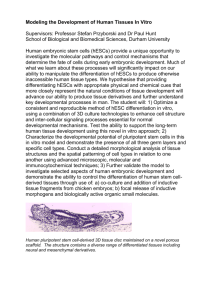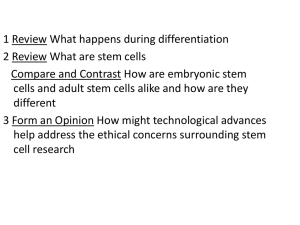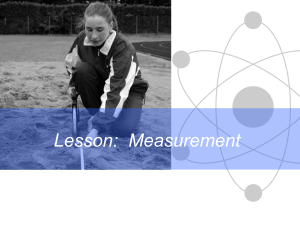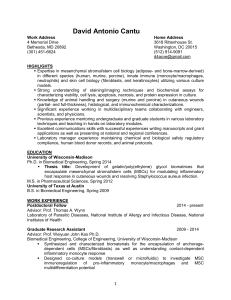Effects of cyclic tensile strain on the differentiation of bone marrow
advertisement
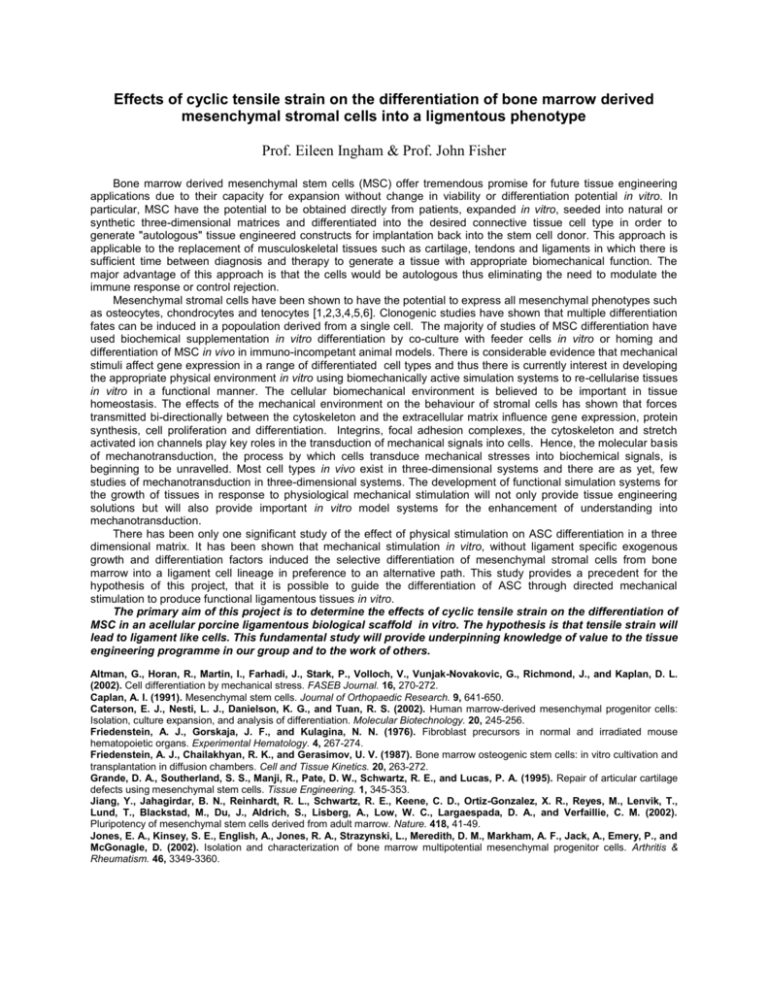
Effects of cyclic tensile strain on the differentiation of bone marrow derived mesenchymal stromal cells into a ligmentous phenotype Prof. Eileen Ingham & Prof. John Fisher Bone marrow derived mesenchymal stem cells (MSC) offer tremendous promise for future tissue engineering applications due to their capacity for expansion without change in viability or differentiation potential in vitro. In particular, MSC have the potential to be obtained directly from patients, expanded in vitro, seeded into natural or synthetic three-dimensional matrices and differentiated into the desired connective tissue cell type in order to generate "autologous" tissue engineered constructs for implantation back into the stem cell donor. This approach is applicable to the replacement of musculoskeletal tissues such as cartilage, tendons and ligaments in which there is sufficient time between diagnosis and therapy to generate a tissue with appropriate biomechanical function. The major advantage of this approach is that the cells would be autologous thus eliminating the need to modulate the immune response or control rejection. Mesenchymal stromal cells have been shown to have the potential to express all mesenchymal phenotypes such as osteocytes, chondrocytes and tenocytes [1,2,3,4,5,6]. Clonogenic studies have shown that multiple differentiation fates can be induced in a popoulation derived from a single cell. The majority of studies of MSC differentiation have used biochemical supplementation in vitro differentiation by co-culture with feeder cells in vitro or homing and differentiation of MSC in vivo in immuno-incompetant animal models. There is considerable evidence that mechanical stimuli affect gene expression in a range of differentiated cell types and thus there is currently interest in developing the appropriate physical environment in vitro using biomechanically active simulation systems to re-cellularise tissues in vitro in a functional manner. The cellular biomechanical environment is believed to be important in tissue homeostasis. The effects of the mechanical environment on the behaviour of stromal cells has shown that forces transmitted bi-directionally between the cytoskeleton and the extracellular matrix influence gene expression, protein synthesis, cell proliferation and differentiation. Integrins, focal adhesion complexes, the cytoskeleton and stretch activated ion channels play key roles in the transduction of mechanical signals into cells. Hence, the molecular basis of mechanotransduction, the process by which cells transduce mechanical stresses into biochemical signals, is beginning to be unravelled. Most cell types in vivo exist in three-dimensional systems and there are as yet, few studies of mechanotransduction in three-dimensional systems. The development of functional simulation systems for the growth of tissues in response to physiological mechanical stimulation will not only provide tissue engineering solutions but will also provide important in vitro model systems for the enhancement of understanding into mechanotransduction. There has been only one significant study of the effect of physical stimulation on ASC differentiation in a three dimensional matrix. It has been shown that mechanical stimulation in vitro, without ligament specific exogenous growth and differentiation factors induced the selective differentiation of mesenchymal stromal cells from bone marrow into a ligament cell lineage in preference to an alternative path. This study provides a precedent for the hypothesis of this project, that it is possible to guide the differentiation of ASC through directed mechanical stimulation to produce functional ligamentous tissues in vitro. The primary aim of this project is to determine the effects of cyclic tensile strain on the differentiation of MSC in an acellular porcine ligamentous biological scaffold in vitro. The hypothesis is that tensile strain will lead to ligament like cells. This fundamental study will provide underpinning knowledge of value to the tissue engineering programme in our group and to the work of others. Altman, G., Horan, R., Martin, I., Farhadi, J., Stark, P., Volloch, V., Vunjak-Novakovic, G., Richmond, J., and Kaplan, D. L. (2002). Cell differentiation by mechanical stress. FASEB Journal. 16, 270-272. Caplan, A. I. (1991). Mesenchymal stem cells. Journal of Orthopaedic Research. 9, 641-650. Caterson, E. J., Nesti, L. J., Danielson, K. G., and Tuan, R. S. (2002). Human marrow-derived mesenchymal progenitor cells: Isolation, culture expansion, and analysis of differentiation. Molecular Biotechnology. 20, 245-256. Friedenstein, A. J., Gorskaja, J. F., and Kulagina, N. N. (1976). Fibroblast precursors in normal and irradiated mouse hematopoietic organs. Experimental Hematology. 4, 267-274. Friedenstein, A. J., Chailakhyan, R. K., and Gerasimov, U. V. (1987). Bone marrow osteogenic stem cells: in vitro cultivation and transplantation in diffusion chambers. Cell and Tissue Kinetics. 20, 263-272. Grande, D. A., Southerland, S. S., Manji, R., Pate, D. W., Schwartz, R. E., and Lucas, P. A. (1995). Repair of articular cartilage defects using mesenchymal stem cells. Tissue Engineering. 1, 345-353. Jiang, Y., Jahagirdar, B. N., Reinhardt, R. L., Schwartz, R. E., Keene, C. D., Ortiz-Gonzalez, X. R., Reyes, M., Lenvik, T., Lund, T., Blackstad, M., Du, J., Aldrich, S., Lisberg, A., Low, W. C., Largaespada, D. A., and Verfaillie, C. M. (2002). Pluripotency of mesenchymal stem cells derived from adult marrow. Nature. 418, 41-49. Jones, E. A., Kinsey, S. E., English, A., Jones, R. A., Strazynski, L., Meredith, D. M., Markham, A. F., Jack, A., Emery, P., and McGonagle, D. (2002). Isolation and characterization of bone marrow multipotential mesenchymal progenitor cells. Arthritis & Rheumatism. 46, 3349-3360.
